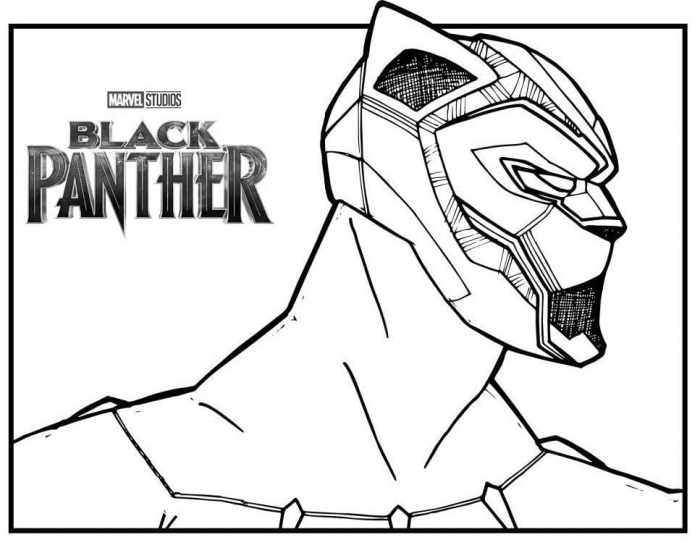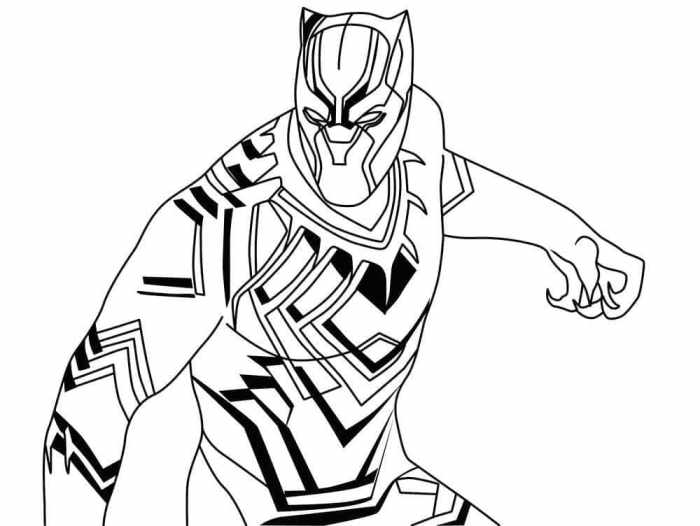Black Panther Anatomy for Coloring Pages

Black panther coloring page animal – Creating accurate and engaging coloring pages of black panthers requires a solid understanding of their anatomy. This guide details key features to help illustrators capture the essence of this majestic feline. The focus will be on aspects easily translatable into visually appealing coloring page designs.
Black Panther Physical Characteristics
Black panthers, which are actually melanistic leopards or jaguars, possess a sleek, muscular build. Their powerful legs are well-suited for both stealthy movement and powerful leaps. When coloring, emphasize the rippling muscles along their back and shoulders, especially in adult panthers. The fur, though appearing entirely black, often reveals subtle variations in shade depending on the light. These nuances can be represented through varying tones of dark grey and black in a coloring page.
Their paws are large and round, equipped with sharp, retractable claws – these can be simplified for coloring pages but should still suggest their strength and function.
Black Panther Head Details
The head of a black panther is characterized by a broad skull and a relatively short muzzle. The eyes are round and expressive, typically depicted as yellow or golden in coloring pages, although their actual color might vary slightly. The ears are rounded and set relatively high on the head, positioned on the sides, offering a striking contrast to the overall shape.
The jaws are strong, capable of delivering a powerful bite. For coloring pages, attention should be paid to the subtle curves of the head and the powerful jawline.
Black Panther Cub vs. Adult
A black panther cub exhibits distinct differences from an adult. Cubs are significantly smaller, with shorter legs and a rounder body. Their features are softer, with less defined muscle structure. Their fur might appear slightly less dark, potentially showing a hint of the underlying base coat. Conversely, an adult panther has a more elongated body, a more pronounced musculature, and a more developed head structure with a defined jawline.
These differences provide opportunities for creating age-appropriate coloring pages, offering simpler designs for younger children and more detailed ones for older children.
Comparative Anatomy of Big Cats
The following table compares the anatomical features of a black panther to other big cats, offering a comparative perspective for coloring page design. Note that these are generalizations, and individual variations exist within each species.
| Feature | Black Panther (Melanistic Leopard/Jaguar) | Lion | Leopard |
|---|---|---|---|
| Body Size | Medium to large, depending on species | Large | Medium |
| Coat Pattern | Uniformly dark (melanistic) | Tawny with mane (males) | Rosettes (spots) |
| Head Shape | Relatively short muzzle, round ears | Large head, rounded ears | Relatively small head, rounded ears |
| Leg Length | Medium length | Long legs | Medium length |
| Tail Length | Long and thick | Long and bushy | Long and thick |
Black Panther Habitats and Poses for Coloring Pages: Black Panther Coloring Page Animal

Black panthers, while not a separate species but melanistic variations of several big cat species (most commonly jaguars and leopards), inhabit diverse environments across the globe. Understanding these habitats and the panther’s typical behaviors is crucial for creating engaging and realistic coloring pages. This section details suitable habitats and poses, providing visual descriptions ideal for artists.
Black Panther Habitats: Visual Elements for Coloring Pages
The natural habitats of black panthers offer a rich palette for coloring page backgrounds. The visual elements within these habitats significantly impact the overall aesthetic and realism of the final product. Consider these key aspects:
- Jungle/Rainforest: Lush, vibrant greens dominate. Vines, thick foliage, and large, broad-leafed plants create a dense, shadowy undergrowth. Consider incorporating colorful flowers, like orchids, and various shades of green to represent the diversity of plant life. Add details like towering trees with thick trunks and intricate root systems for a three-dimensional effect. The background should feel humid and alive.
- Savannah: A stark contrast to the jungle, savannahs feature tall grasses, scattered acacia trees, and rocky outcrops. Use various shades of beige, brown, and yellow to depict the dry grasslands. The trees should be sparsely placed, creating a sense of openness. Include details like termite mounds and small shrubs for visual interest. The overall feeling should be one of open space and intense sunlight.
- Mountainous Regions: In some regions, black panthers inhabit mountainous terrain. Here, the focus should be on rocky landscapes, rugged cliffs, and dense forests clinging to the mountain slopes. Use a palette of dark browns, grays, and greens. Incorporate snow or ice in higher altitudes depending on the specific location. The scene should convey a sense of altitude and ruggedness.
Black Panther Poses: Dynamic Coloring Page Designs
The pose of the black panther is critical in conveying a sense of action, emotion, or stillness. Different poses lend themselves to different moods and narratives within the coloring page.
- Stalking Prey: The panther is low to the ground, muscles tense, body elongated and poised for a sudden burst of speed. The head is lowered, eyes focused intently on an unseen target. This pose creates a sense of suspense and anticipation.
- Leaping: The panther is mid-air, limbs extended, body arched. This pose demonstrates power and agility, capturing a moment of dynamic action. Consider showing blurred motion lines to enhance the sense of speed.
- Resting: The panther is relaxed, curled up or stretched out in a comfortable position. This pose creates a sense of peace and tranquility. The muscles are less tense, conveying a feeling of rest and contentment.
Three Distinct Coloring Page Scenes, Black panther coloring page animal
Below are three scene ideas combining the previously discussed habitats and poses:
- Scene 1: A black panther stalking prey through a dense rainforest. The panther is low to the ground, its dark fur blending seamlessly with the shadows of the jungle undergrowth. The background is rich with vibrant greens and various shades of brown, representing the forest floor and dense foliage.
- Scene 2: A black panther leaping across a savannah. The panther is mid-air, its sleek body silhouetted against the setting sun. The background is composed of long grasses and scattered acacia trees, creating a feeling of open space and movement.
- Scene 3: A black panther resting on a rocky outcrop in a mountainous region. The panther is curled up, its dark fur contrasting against the gray and brown rocks. The background features rugged cliffs and snow-capped peaks, conveying a sense of isolation and grandeur.
Light and Shadow Effects on Black Panther Fur
The interplay of light and shadow is crucial for creating depth and realism in a black panther coloring page. Because the panther’s fur is black, the light and shadow effects are particularly important in defining its form and texture.
- Direct Sunlight: In direct sunlight, the fur will appear almost entirely black, but subtle highlights might appear on raised areas like the cheekbones, shoulders, and spine. These highlights should be represented with a slightly lighter shade of gray or dark blue to avoid a flat appearance.
- Shadowed Areas: Areas in shadow will be significantly darker, almost pure black. However, avoid making them completely black; instead, use very dark shades of gray or blue to create depth and prevent the panther from appearing two-dimensional.
- Reflected Light: Consider adding subtle hints of reflected light in shadowed areas. This can be achieved using a very light gray or blue, suggesting that light is bouncing off surrounding surfaces and illuminating the panther indirectly.
The majestic black panther, a creature of power and grace, is a popular subject for coloring pages. Children often enjoy depicting its sleek, dark fur. This contrasts nicely with the cuteness of other coloring page subjects, such as the adorable big eyed stuffed animals coloring pages , which offer a different kind of artistic expression. Returning to the black panther, its powerful form provides a wonderful opportunity to practice shading and detail work, developing artistic skills while learning about this magnificent animal.
